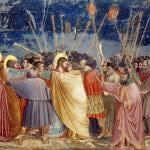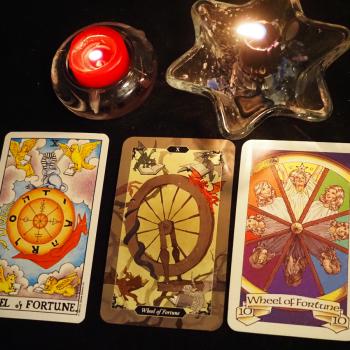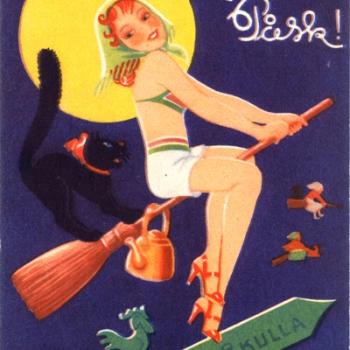A little over a year ago, medieval historian and podcaster, Eleanor Janega wrote a blog post that caused some consternation amongst the witchcraft community for its roughly handled opinion, coupled as it was with assumed scholarly pedigree and a rather haughty mien. Whilst there are some glaring historical errors and misconceptions throughout the modern witch community, and the principal thrust of the post was targeting tasteless t-shirts that use a feminist slogan — “We are the granddaughters of the witches you couldn’t burn” — there was, nevertheless, a rather unpleasant undercurrent to the piece that undermined the realities of witchcraft in history, simultaneously belittling some of the experiences of those adhering to its practice today (unless you’re one of Janega’s friends who self-identify using modern interpretations, in which case she gives you carte blanch to believe yourself a witch).
…But they weren’t witches. Alizon [Device] just … had a lot going on. Because you cannot in fact sell your soul to the devil and get the powers to take out people’s legs in return. This is a fact.
— Eleanor Janega, You are not, in fact, the granddaughters of the witches they couldn’t burn.

Whilst the offending t-shirts and slogan have become trite and embarrassingly overused by the modern crop of popular witchcraft adherents, there is, nevertheless, a lot that needs careful thought. One necessary argument within Janega’s blog post addressees the glamourising and appropriation of the witch hunts, along with the torture and execution of innocents and downtrodden, to promote a false sense of identity that has become banal. It is incumbent, then, upon this author to establish where the aforementioned phrase arose, by whom and its use as a rallying cry for feminism. As these are the main points of Janega’s article, they ought to be addressed first.
The phrase “we are the granddaughters of the witches they couldn’t burn” finds its origin within the writing of Italian-American feminist scholar and Marxist activist, Silvia Federici, professor emerita and teaching fellow at Hofstra University in New York State. In her 2004 work, Caliban and the Witch: Women, the Body and Primitive Accumulation, Federici argues around the development of capitalism and the subjugation of woman and exploitation of their labour throughout the late medieval and early modern periods. In Federici’s discourse, the origins of capitalism are examined through, amongst other things, the formulation of the idea of relationships, with particular attention to the role of women as a necessary, yet expropriated member of society. For Federici, the witch hunts themselves were not simply about religious persecutions, but demonstrated a restructuring of society and the role of women, their bodies and labour being commonly regarded as property to be used — often as capital itself in negotiations — and subjugated. While the phrase may be a paraphrasing of Federici’s ideas, the scholar does posit the notion that those today who fight for liberation, against the capitalist, patriarchal order of society, inherit the energy and momentum of those who were persecuted for their open challenge to the status quo. In this way, the phrase became a catchphrase specifically for feminist activism as it highlights the ongoing struggle for women’s rights — consider prohibitive abortion laws — by drawing from the collective egregore and numen of those who have become the foundation of the effort, be they historical or symbolic.
Whilst Janega’s blog post may or may not address counter-arguments to Federici’s powerful message, this is not directly indicated in the post that is situated, principally, as an opinion piece concerning the existence of a popular and commercialised slogan (ironically, considering Federici’s Marxist anti-capitalist credentials). One could agree that, given Federici’s feminist sentiment, the t-shirt is in poor taste and out of context. As most blog posts, however, are concerned with personal reflection and opinion, this does not formulate the main offending theme that underpins Janega’s argument. Rather, the essential issue for Janega is to be found in the assertion that, historically, whatever people’s experience or belief, they can’t have been witches because, according to Janega, witchcraft simply doesn’t exist.
This is not to say that some people accused of witch craft didn’t confess to it on occasion, or maybe even think they were doing some witch ass shit. But that doesn’t mean they actually were doing it.
— Eleanor Janega, You are not, in fact, the granddaughters of the witches they couldn’t burn.
In Janeg’a argument, a quote from the canon episcopi is used to demonstrate that:
People might think they were doing some pagan shit and hanging out with Diana (seems cool, ngl), but in fact they were just delusional and [according to the canon episcopi] if they thought this [then] they needed religious intervention because they had been deceived into thinking that they were.
— Eleanor Janega, You are not, in fact, the granddaughters of the witches they couldn’t burn.
The entirety of the article is predicated upon the supposition that witchcraft isn’t a reality, and that is where the argument ends for Janega. Which is interesting because it is merely the starting point for many of those historians who study and teach the subject, such as Edward Bever, Professor of History and Director of the School of Professional Studies at SUNY Old Westbury, and a current leading authorities and scholar upon the subject.
In The Realities of Witchcraft and Popular Magic in Early Modern Europe: Culture, Cognition, and Everyday Life (2008), Bever presents a thoroughly researched work that explores the reality of witchcraft as it was directly experienced and engaged in through the late medieval and early modern period. This mammoth book achieves its goal through a “… combination of detailed archival research and broad-ranging interdisciplinary analyses, this book complements and challenges existing scholarship…” [1].

Janega’s blasé contention that witchcraft was not a reality during the medieval and early modern periods, that those who believed such were delusional or “had a lot going on” [2], may be countered in the following exert from Realities:
… “reality” is understood to include perceived experiences regardless of whether the source of the perceptions appears to us to have been internal or external, both because in at least some cases it is clear that the people involved really did experience the things they described, which means that the experiences were real even if we think they did not correspond to any external physical events, and also because even imagined experiences have a physical dimension in the neurological processes that make them manifest.
Second, it should probably be noted upfront that the evidence does not vindicate the demonologists’ fear that there was a cohesive, widespread underground movement of Devil-worshipping witches. However, it also does not support the idea that this fear was based only on scholastic reasoning and clerical misogyny, displaced social tensions, or even a compendium of popular beliefs. Instead, it indicates that not only its details but also its overall structure reflected actual experiences and practices as well as thoughts, beliefs, and stories and were created, sustained, and developed through a dynamic interaction between learned theories, popular beliefs, and some peoples’ real activities and perceptual experiences.
— Edward Bever, Realities of Witchcraft [3]
Bever here directly addresses the assertions outlined in Janega’s blog post, making plain that the reality is a rather nuanced, complex and fluid coincidence of people, belief, culture and experience that is reflected in a large amount of data and research. This cannot be succinctly summarised in a scathing attack on traditional witchcraft beliefs, historical or modern, and caveated with the exception made for those moderns who self-identify with the popular rendition of today. There are very genuine examples of real, lived experiences recorded of those who practiced witchcraft — both believing and witnessing its effects. Whilst witchcraft is an easy target to renounce as delusion, one wonders if such a scholar as Janega would be as bold to state the same conclusions with regard the visions of Ezechiel, John of Patmos (Book of Revelation) or Paul of Tarsus — all of which are referenced in the canon episcopi as parallel to the nightly transvection* of witches and pagans through dream and “phantasms”, rather than physical or bodily occurrences.
Janega is right, after all, that the t-shirt discussed is a trite motif capitalised upon by those unaware of, or blind to, the horrors of the witch trials. Arguably, the phrase is a rallying call around which feminist activists draw the power to fight against the norms that oppress them. Finally, Janega does not get to assert that witchcraft wasn’t a reality, nor that a single opinion on that subject constitutes an authoritative or scholarly position — certainly not the last word on the subject.

* The folkloric flight of witches to the Sabbath.
Footnotes:
[1] https://link.springer.com/book/10.1057/9780230582118 [accessed 17th February, 2025] [2] https://going-medieval.com/2023/10/20/you-are-not-in-fact-the-granddaughter-of-the-witches-they-couldnt-burn/ [accessed 17th February, 2025] [3] Bever, Edward. 2008. The Realities of Witchcraft and Popular Magic in Early Modern Europe. Springer. p67. My new book will be published in March 2025 through Ninth Circle Press. Following the link to subscribe to the Ninth Circle Press newsletter and receive notification when it is available to purchase. This book will be limited print.
My new book will be published in March 2025 through Ninth Circle Press. Following the link to subscribe to the Ninth Circle Press newsletter and receive notification when it is available to purchase. This book will be limited print.
N.B. I did write an original response to Janega’s post when it began being circulated on social media. This is not that piece.


















